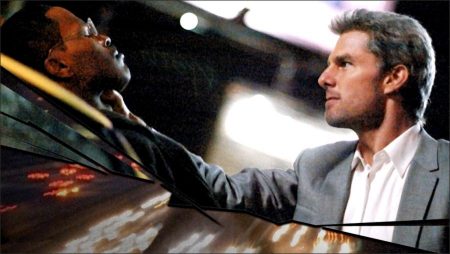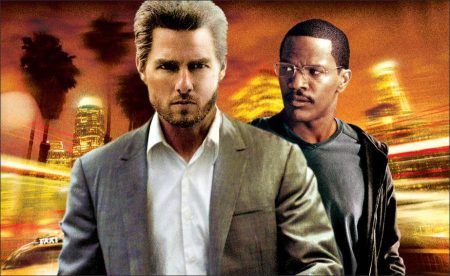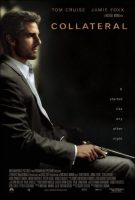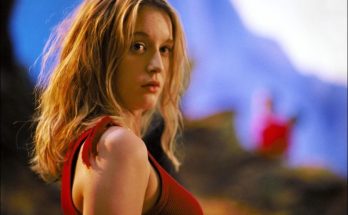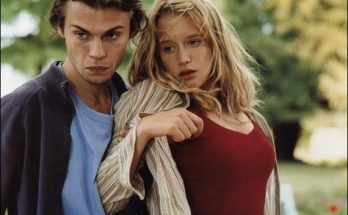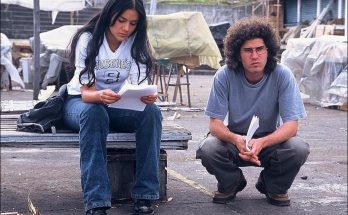Collateral takes place over one night in Michael Mann’s City of Los Angeles. But in that one night, the lives of two men will be irrevocably changed. Director / producer Michael Mann states, “One of the things that attracted me to the project was the compression of time-it all happens in one night. The whole story takes place between six p.m. and about four a.m. in this PacRim-diverse and most contemporary of American cities, where coyotes roam the streets as if the layer of civilization is new and temporary.
That’s the world I wanted Max and Vincent moving through as the story unfolds. Tonight, everything in their lives is changing. Totally. Forever. Finality has shown up on the horizon, heading this way. This is the collision of two lives in very extreme circumstances. It is a compression of all they have been and who they think they might be, all collapsed into the events of one night. I liked the intensity, the immediacy of that…”
Mann adds that it was as if the script broke the convention of the standard three-act structure, with a typical beginning, middle and end. “It’s almost as if there had been two acts prior to the beginning of our movie-all kinds of events had occurred with many discoveries along the way-and now here is the denouement of the story. The whole movie is the third act, which was very attractive to me.”
Nevertheless, moviegoers will have no reason to wonder how they got to this point in the story, as the back story that led to this one night becomes all too clear as the drama unfolds. Mann expounds, “An offshore narcotrafficking cartel has discovered that some of their operatives are about to be indicted in Los Angeles. They mount an operation to stop these indictments by killing the five key witnesses. Understand, they are very large and have an unlimited budget, so they can buy the best people available to get the job done… people like Vincent. They probably spent months setting up this operation; all the prep work has been done. Now it’s just a matter of carrying it out…and tonight Vincent comes to town to do exactly that. Unforeseen circumstances compel him to have to improvise and he winds up taking a hostage-a cab driver named Max.”
“Max becomes a hostage in his own cab as Vincent makes him drive to the places where these hits will be carried out,” screenwriter Stuart Beattie continues. “And the guts of the story is these two characters in what becomes very much a mano y mano game of cat and mouse.”
Perhaps surprisingly, it wasn’t the idea of going inside the mind of a contract killer that first inspired Stuart Beattie’s script for “Collateral.” Rather, it was the day-to-day risks of being an ordinary, everyday cab driver. The screenwriter offers, “It came from my own experience of taking a cab back from the airport one day. I started talking with the cabbie, and by the time I got home, we were chatting like old friends. Suddenly it occurred to me that I could be anybody and the driver would have no idea. I could be some homicidal maniac and he has his back to me the whole time. It struck me as being a potentially interesting setting for a drama, where you have two complete strangers sitting, one with his back to the other, in an enclosed space, totally alone. And it just grew from there.”
Who’s Driving Whom?
In a rare villainous turn, Tom Cruise stars in the role of Vincent, though he doesn’t see even this cold-blooded killer in entirely black and white terms. “I’ve played heroes and antiheroes, and I thought Vincent was just a great character… very dynamic,” Cruise says. “I wanted to explore the character and get an understanding of him, particularly because he’s demonstrating some seriously antisocial behavior,” he laughs. “One of the first things I try to do is find the character’s moral code because, whether you agree with them or not, people have their own moral codes. Vincent was hired to do a job and it would be a breach of his moral code not to do it. He’s an absolute professional. I looked at it from that point of view.”
“I think people are very complex, and there are many things at work within them that can be fascinating,” Mann comments. The director could be talking as much about his star as the character he plays, noting, “Vincent is a character unlike any Tom has played before, and there was an element of risk for him to do this role. There is a power and an authority within Tom that I wanted to see come out in this character. You can see it, even through Vincent’s elegant appearance. You realize, soon, he is rough trade in a good suit.”
Vincent’s appearance also represents something of a departure for Cruise, with his steel gray hair and salt-and-pepper stubbled face. “I wanted the character to look very different from Tom Cruise, to rough up the surface appearance and give him a certain anonymity,” Mann asserts. “It was also in the wardrobe, which was very important because Vincent is in the same suit throughout the movie. It looks like very expensive custom tailoring, but not done in the United States or even Europe… like it’s the best custom tailoring money can buy in a place like Kowloon, so it has a certain foreign element to it.”
“Michael came up with the whole visual design of the character-the hair, the beard, the suit…,” Cruise remarks. “We worked it out on the computer first and Michael’s eye is incredible. I just loved working with him; he was so absolutely thorough. We took the time to put together Vincent’s history, and those back stories very much gave us a point of reference of where to start with the character and where to go.”
“We spent months prior to filming building Vincent into a very dynamic, very tangible character, none of which is discussed specifically within the context of the movie,” Mann reveals. “But it is there in everything that Vincent does. There’s not a reaction, an attitude, or a line of dialogue that doesn’t connect back to the part of Vincent that predates tonight, when the story begins. Through various bits and pieces, we get the sense that something is going on inside of this character. There are tectonic plates shifting deep down in the core of this person.”
“One of the things we always discussed was when do you start to see that first crack appear in Vincent’s veneer,” Cruise says. “At the beginning of the picture, he looks just perfect… a silver fox coming into town. But I believe that Max definitely has an effect on Vincent, so it’s on this night that there is a crack of humanity in this guy.”
Mann agrees, “Vincent is an intelligent man, but he has been making a living killing other human beings for the last six or seven years. To the extent that his personality has been eroded over time, he couldn’t have found himself a worse person with whom to spend a night in a vehicle than Max.”
Jamie Foxx, who stars as Max, confirms that once his character gets over the initial shock of finding out who Vincent is and what is going on, there is a gradual shift in their relationship. “The amazing thing about the relationship between these two guys is that, in some crazy way, Max is inspired by Vincent. It’s as if Max has been just bursting at the seams for something different in his life, and when it happens he eventually embraces it.”
Michael Mann says that Foxx was “perfect casting” for the role of Max, noting, “Jamie is truly `a man for all seasons’; he is a phenomenal talent…just a brilliant actor. The film is not even remotely comical, but there are scenes with Jamie and Tom that are devastatingly funny. Nobody knows how to carry those moments with the kind of precision needed better than Jamie Foxx.” The director adds, “It also had to do with the chemistry of Jamie and Tom together, though their characters are total opposites. Max is middle class. He’s an everyman character. He has conventional values, believes in civic duty and has humanitarian impulses. He has never seen a violent crime in his entire life… and he winds up with a stone cold sociopath in his back seat.”
Foxx states, “At the beginning of the movie, Max is entirely unconcerned about who this guy in the back is. He’s just another fare because Max is simply a cab driver. My way of thinking was that there was nothing special or exciting about Max’s life, other than the fact that he is kind of a dreamer. Vincent getting in his cab is going to change him forever, but the reality is that on this night they both end up needing each other to decide which way their lives are gonna go. For Max, either he is going to stay in that cab for the rest of his life or, because of this tragic thing, is going to do whatever he needs to in order to make sure that he doesn’t go back to that metaphoric four-doored jail cell any more. I believe people happen to people on purpose-not all the time, but there are some energies that are pushed together for a reason. There are a couple of things that happen to Max like that. When Jada’s character, Annie, gets in the car and meets Max, they share a few ideas with each other and all of a sudden their lives have changed a little bit. She turns around and gives him her business card. Annie is a very attractive woman, very powerful… why give her card to a cab driver? But something made her change.”
Jada is Jada Pinkett Smith, who stars as United States Attorney Annie Farrell. The actress affirms, “One of the themes of the film that was really interesting to me was how people’s paths cross-the dynamics of meeting someone you never imagined could affect you in such a substantial way. That’s what happens with Annie and Max. He gives her the opportunity to express who she really is, and she feels comfortable enough with him to open up and reveal something about herself she probably hasn’t told another human being. When she gets out of the cab, she’s thinking, `I might never see this guy again… maybe I should give him my card… but he’s a cab driver.’ But they had made this incredible connection, and it broke through any preconceived ideas of who this cat might be. It just teaches you that you have to be open and ready, because you never know what a chance meeting could lead to.”
To prepare for her role, Pinkett Smith spent time with an attorney in and out of the courtroom. She offers, “I watched how she interacted with the other lawyers and how she handled herself in the courtroom versus outside of the courtroom. I observed her body language and even her wardrobe-why she wore a skirt instead of pants, heels as opposed to flats, how much makeup she wore…
All of these things help to create a character, so to have the opportunity to work with a director like Michael Mann, who insists on that kind of process and appreciates the work that goes into it, is truly a blessing. It really steps up my game because, if you’re going to work with Michael Mann, you have got to be on point. Period. You have to come to the set prepared, and he helps you do that. He takes you on a journey to access your character.”
Mann counters that he more than appreciated the work Pinkett Smith put into creating her character and says that it paid off where it counts, on the screen. “The brilliance of Jada in this role and the proof of her getting her character right is tested by the story. We meet Annie in the beginning of the film, and she has to make an extremely strong impression on us because we’re not going to see her again until very much later, and she has to be sustained in memory. Jada has this unique charisma as a person in real life, and I believe that’s conveyed in Annie.”
Another person with whom Max has a brief but pivotal encounter is Detective Fanning, an undercover narcotics detective who is hot on Vincent’s trail after the first “hit” gets a little messier than initially planned.
Fanning is played by Mark Ruffalo who says he was immediately drawn into the action by the screenplay. “It was exciting to read. It felt like a hard-driving, twisting, tumbling caper that you don’t know where it’s going to go, but you know it’s driving towards an end. The description of the action was so specific, I could visualize whole sequences reading it, and I’d never had that experience before.”
Ruffalo notes that he had first envisioned Fanning as being very “street,” but remarks, “Michael wanted to class him up because Fanning is the first one to see the truth of what’s going down and he’s on the trail of the killer, so he needed to be comparable in some way to Vincent. I told Michael I had no idea where to begin and he said, `I’ve got just the guy for you.’ He handed me a picture of a detective we just called `Q’ and said, `This is the guy. I want you to spend as much time as you can with him before we shoot this movie. You are `Q.’”
Mann says, “`Q’ is an undercover narc. I’ve met a lot of undercover cops in my life and if somebody had pointed `Q’ out to me on the street and said, `That guy’s a cop,’ I’d have said, `Impossible.’ To look at him, there is no way you would think he is an LAPD detective working major narcotics. In many respects, he is who I based Mark Ruffalo’s character on.”
Rounding out the main cast of “Collateral” are Peter Berg as Narcotics Detective Richard Weidner, who is skeptical about his partner Fanning’s theories about the crime; Bruce McGill as Pedrosa, a Federal Agent investigating the narcotrafficking cartel that hired Vincent; Barry Shabaka Henley as Daniel, a jazz musician who finds himself on Vincent’s list; and Irma P. Hall as Max’s bedridden but still feisty mother, Ida. Academy Award nominee Javier Bardem (“Before Night Falls”) makes a cameo appearance as Felix, one of the heads of the narcotrafficking cartel and the one who hired Vincent, sight unseen.
Building Characters
Mann acknowledges that pairing Pinkett Smith with a real-life attorney and Ruffalo with an undercover cop to give them added insight into their respective roles is part of his general approach as a director. “I’m a big believer that whatever the central activity is that a character does in life, an actor, and sometimes I as a director, should also be able to do to really understand the character. It provides all kinds of access into the depths of the person.”
To that end, both Tom Cruise and Jamie Foxx underwent very individual training regimens to identify more fully with their individual characters. Cruise trained extensively with Michael “Mick” Gould, a former member of the British Special Air Service and a respected authority in the areas of martial arts and weapons training. In recent years, Gould has turned his expertise into a career as a consultant and instructor for clients ranging from military Special Forces and law enforcement to feature films. He had first been recruited to work in motion pictures by Michael Mann on the movie “Heat,” and Mann called on him again to give Cruise, one of the industry’s most affable stars, the makings of a consummate killer.
For the scenes involving gun play, Cruise practiced on a police firing range with live ammunition, which gave him a familiarity with the feeling of firing a real gun that is impossible to get from firing blanks. Using live ammunition also gave the actor a respect for the weapon, even when it was later loaded with blanks. “I’ve fired weapons in pictures before, but I’d never had that kind of training with a gun,” Cruise states. “Mick is a great instructor. He helped me to find my own style and also trained me beautifully so I was very safe when using a weapon. I couldn’t afford to make a mistake because even though you’re firing blanks, they are full-flash blanks and could hurt somebody. But it also added a dimension to the character that I really enjoyed exploring. It was like building the character from the ground up, so when it came time to do those scenes, I felt very confident. I didn’t have to think about it; this is just who Vincent is…this is what he does.”
Mann says, “In directing Tom, I was working with someone who has the most complete focus and dedication to being there and making himself available to everything. You believe that Tom can do what his character does in the picture for the simple reason that Tom can do everything his character does in the picture. All those skills were acquired in pre-production.”
While Cruise was on the firing range, Jamie Foxx was racing Ford Crown Victorias at Willow Springs Racetrack. “To be honest, I didn’t understand why we were on a racetrack,” Foxx admits, “but Michael said he needed me to have the feel of the cab, so driving it became second nature and not acting. He said, `If you’re acting, it’s a cab, but if it’s natural, you’re not paying any attention to the cab at all.’ And when it came to the stunts, he wanted me to be comfortable with the car going fast-how it moves and turns at any speed. We ended up having a great time at the track. It was a whole lot of fun, but at the same time, I got a little of Max’s DNA.”
“It was important,” Mann adds. “If you’ve been driving a cab twelve hours a day, five days a week, year after year, you’ve got to be a pretty instinctive driver. He had to know how to control the vehicle and get sensitized to the weight transference, its effect on traction, like that… That’s one of the basics of racing, so we did just that… except with a Crown Vic.”
Interestingly, it was the act of not driving that proved the most challenging to Foxx. Since most of the action takes place in the confines of a taxicab, there were 17 cabs and assorted configurations of cabs used during the filming of “Collateral.” On some of the cabs, various sections could be removed to accommodate different camera angles. Obviously, a few of those 17 cabs were not meant to be driven, but rather “towed” as the action inside was filmed. In those scenes, Foxx wasn’t actually driving the cab and, the actor reveals, that took some getting used to. “I was turning the steering wheel back and forth, and Michael would have to cut and say, `Quit turning the steering wheel like that.’ Sometimes, it was completely black-you couldn’t see anything-and I’d just be staring, and I’d hear, `Cut. You can’t just stare when you’re driving,’” Foxx laughs. “After a few nights, I got the hang of it.”
A great deal of thought went into both the interior and exterior look of the cab, which is the primary “set” of the entire movie. If, as the saying goes, “God is in the details,” then it could also be said that Michael Mann is a true believer. The paint scheme of the cab went through no less than 50 incarnations before the design team achieved the desired color. Although the predominant color could be considered a deep orange, Mann wanted a subtle bluish opalescence mixed in that would give it a different sheen under the city’s nocturnal haze. “This is L.A. It’s not Chicago, it’s not New York, it’s not Detroit… The air has a certain liquidity to it at night. It’s the way things are in L.A., so it became very important that the color of the cab be just right.”
Night Lights
“Collateral” was shot entirely at night in the city Michael Mann arguably knows better than any other contemporary director: Los Angeles, California. “Michael Mann has been to places I didn’t even know existed,” says Foxx. “I tried to tell him, `Mike, I’m from the ghetto,’ and he said, `You’re not from the ghetto. I know the ghetto. You want me to show you some ghetto?’ And he took me places where even I was like, `Man, lock the doors! Where are we?’ That’s the genius of it. Michael doesn’t try to make Toronto or Vancouver look like L.A.; you’re actually in L.A., with somebody who really knows this city.”
Production designer David Wasco agrees, “A lot of filmmakers think Los Angeles has been filmed to death, but there’s so much that’s still untapped. Part of showcasing the city was in representing a wide variety of communities and cultures, the upscale and the downscale.”
Mann comments, “For people who don’t live here or for some who do, it’s not the Los Angeles of palm trees and Malibu, but the city of Los Angeles-Commerce, Wilmington, South Central, East L.A., downtown… And there is a unique mood to the skies above L.A. at two or three a.m. Streetlights reflect off the bottom of clouds. Even in darkness, you can see into the distance: silhouetted palms against the sky… I had to figure out how we were going to evoke that three-dimensional night-how to see into the L.A. night.”
Mann knew that standard 35-millimeter film would never be able to capture Los Angeles at night the way he wanted the audience to experience it, so he became one of the first directors to shoot a major motion picture almost entirely digitally, and the first to use a modified Thomson Grass Valley Viper FilmStream camera to depict the city in the hours between dusk and dawn as never before.
“Film doesn’t record what our eyes can see at night,” Mann confirms. “That’s why I moved into shooting digital video in high definition-to see into the night, to see everything the naked eye can see and more. You see this moody landscape with hills and trees and strange light patterns. I wanted that to be the world that Vincent and Max are moving through.”
Mann worked closely with associate producer Bryan H. Carroll on the modification of the Viper to make it the optimum medium in which to shoot the movie.
“Collateral” actually turned out to be a multimedia film project, with approximately 80 percent of the film shot digitally, using several different types of cameras, including the Viper FilmStream and the Sony CineAlta high definition camera, and the balance on traditional film. Mann explains that the primary benefit of the Viper FilmStream was the way it recorded the distinct color palette that defines the city at night. “The Viper records colors in a whole different way, particularly oranges, yellows and reds.”
Nevertheless, the director notes, “To me it’s about emotion; it’s how those environments surrounding these characters make us feel, so the atmosphere around them was quite critical. I find Los Angeles at night to be very emotional. I wanted to tell a story that evokes some of the wildness that lurks just one layer below the surface.”
That wildness is conveyed in a brief encounter between Max and Vincent and three coyotes crossing the street in front of the cab. The scene resulted from Mann’s own experience, as he relates, “I was driving home late one night and stopped at a red light, and three coyotes walked diagonally across the intersection like they absolutely owned it. It was something I never forgot. It wasn’t just the presence of wild animals in the middle of the city; it was their attitude that this was still their domain, and this layer of civilization was merely temporary.”
Cruise says that he feels the scene in which Vincent and Max cross paths with the coyotes “has a hypnotic quality. In that moment you see these two guys are in their own world, yet they are connected. They’re on this journey together.”
Collateral (2004)
Directed by: Michael Mann
Starring: Tom Cruise, Jamie Foxx, Jada Pinkett-Smith, Mark Ruffalo, Peter Berg, Irma P. Hall, Bruce McGill, Barry Shabaka Henley, Debi Mazar, Javier Bardem, Jamie McBride
Screenplay by: Stuart Beattie, Frank Darabont
Production Design by: David Wasco
Cinematography by: Dion Beebe, Paul Cameron
Film Editing by: Jim Miller, Paul Rubell
Costume Design by: Jeffrey Kurland
Set Decoration by: Sandy Reynolds-Wasco
Art Direction by: Daniel T. Dorrance
Music by: James Newton Howard
MPAA Rating: R for violence and language.
Distributed by: DreamWorks Pictures
Release Date: August 6, 2004
Views: 118
